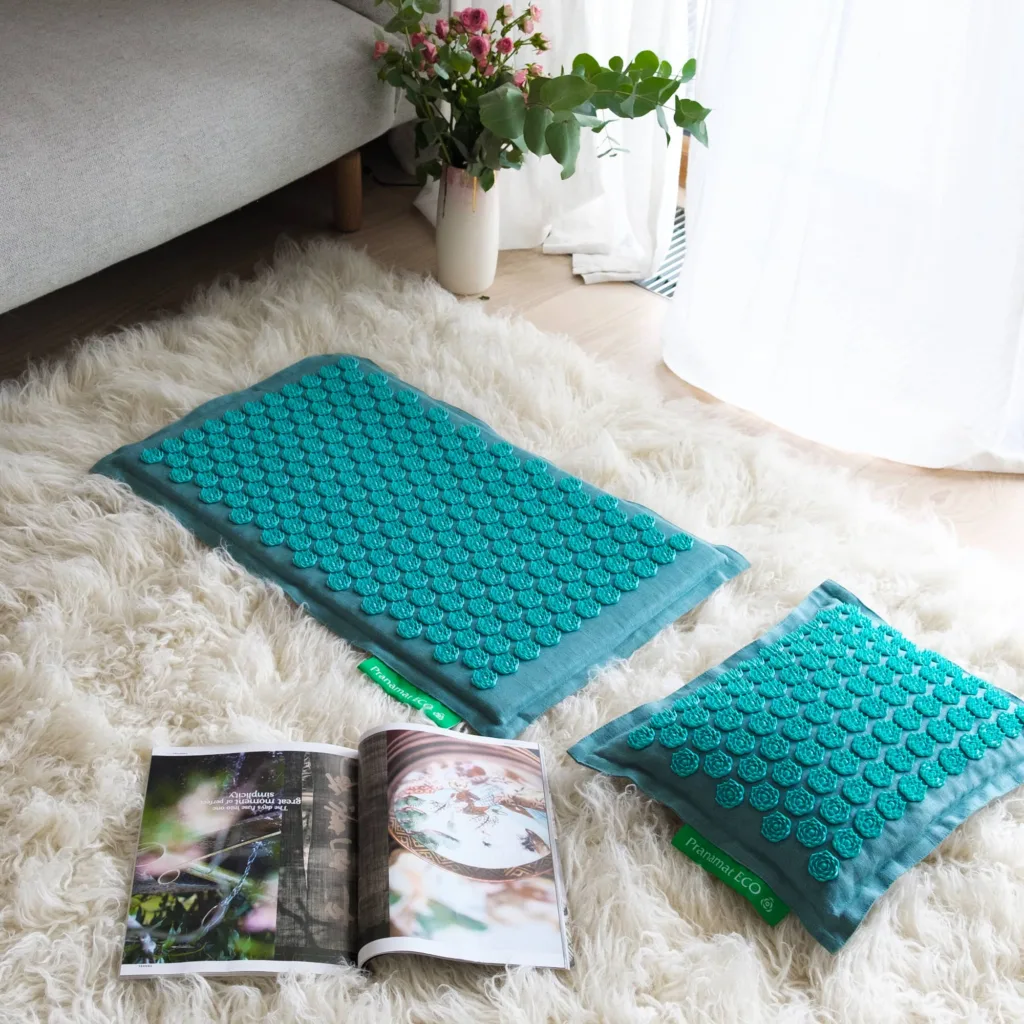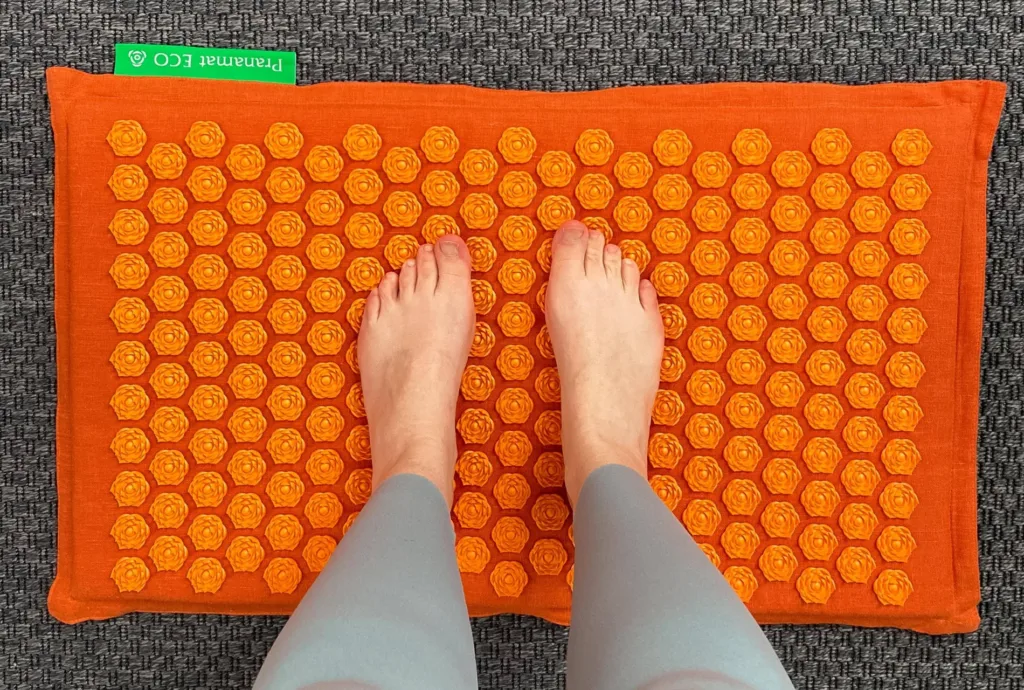Are you struggling with the persistent pain and fatigue that come with fibromyalgia? As an acupressure specialist, I’ve had the opportunity to work with numerous clients, including patients with fibromyalgia, in search of effective fibromyalgia new treatments. I’m excited to share my experience and insights on how acupressure can be a powerful treatment for fibromyalgia. In this blog post, we’ll dive into the world of acupressure points for fibromyalgia and explore how this ancient healing technique can alleviate some of the most debilitating symptoms of fibromyalgia.
Living with fibromyalgia can be challenging, but there’s hope. Targeting specific acupressure points can help relieve pain and fatigue, regulate serotonin and norepinephrine levels, and enhance your overall well-being.
So, let’s embark on this journey together and discover the potential benefits of acupressure as a treatment of fibromyalgia!
Fibromyalgia new treatments – Acupressure
As an acupressure specialist who has worked with many clients experiencing fibromyalgia, I can confidently say that acupressure is a solution worth considering to treat fibromyalgia.
While conventional treatments, like medications approved by the Food and Drug Administration, may help manage the symptoms of fibromyalgia syndrome, they’re not always effective for everyone. For people with fibromyalgia who also suffer from conditions like arthritis, finding relief can be even more challenging. This is where acupressure comes in as a promising non-pharmacological treatment option.

The beauty of acupressure lies in its gentle, non-invasive nature, making it suitable for individuals with various health conditions.
Recent clinical trials have demonstrated the potential benefits of acupressure in alleviating pain, fatigue, and other symptoms associated with fibromyalgia. As a result, more and more people are turning to this ancient healing practice for a safe and effective alternative treatment.
How Acupressure Works
Acupressure is a technique that involves applying pressure to specific points on the body to relieve pain and promote healing. It is based on the same principles as acupuncture, but instead of using needles, pressure is applied with the fingers, hands, or specialized tools like acupressure mats.
Acupressure mats are designed with thousands of small spikes that stimulate specific acupressure points when lying down or standing on them. These points help release endorphins, the body’s natural painkillers, and promote relaxation and healing.
Acupressure mats are often used to help relieve pain and discomfort associated with fibromyalgia. Stimulating acupressure points can help relax tight muscles, reduce inflammation, and increase blood flow to affected areas, relieving fibromyalgia symptoms.
Read also: What You Need to Know About Acupressure Mats
Benefits of Acupressure Mats for Fibromyalgia
Acupressure mats have gained popularity as an innovative and convenient tool that can be highly effective in the treatment of fibromyalgia. The numerous benefits of acupressure mats for fibromyalgia treatment make them an attractive option for those seeking relief from the chronic pain and discomfort often accompany this condition.
One of the primary advantages is the ability to alleviate pain associated with fibromyalgia by stimulating the body’s natural pain-relieving mechanisms, making it a great alternative to traditional pharmacological treatment.

Moreover, acupressure mats have been shown to reduce sensitivity in patients with fibromyalgia, helping to ease discomfort and improve the overall quality of life. Whether you’re a fibromyalgia patient with or without additional health concerns, such as arthritis, acupressure mats can offer a safe, non-invasive, and drug-free approach to managing your symptoms.
People diagnosed with fibromyalgia can easily incorporate acupressure mats into their daily routine, providing an accessible and versatile tool to manage fibromyalgia.
Exploring non-pharmacological therapies for fibromyalgia can lead to discovering innovative solutions that greatly improve your quality of life. One such option is acupressure mats, which have been gaining popularity due to their numerous benefits.
Here are some advantages of acupressure mats as a non-pharmacological therapy for the management and relief of fibromyalgia:
- Pain relief: Acupressure mats can help with fibromyalgia pain by stimulating the release of endorphins and promoting relaxation. This can help reduce muscle tension and alleviate pain throughout the body.
- Improved sleep: Fibromyalgia patients often struggle with sleep disturbances, but using an acupressure mat before bedtime can help improve sleep quality.
- Reduced anxiety and stress: Many fibromyalgia sufferers experience anxiety and stress as part of their condition. Acupressure mats can help reduce anxiety and stress by promoting relaxation and releasing tension from the body.
- Improved circulation: Acupressure mats can help improve blood flow and circulation, which can help alleviate some fibromyalgia symptoms such as pain, stiffness, and fatigue.
Best acupressure mat for fibromyalgia
When searching for the best acupressure mat for fibromyalgia, it’s important to note that most acupressure mats can potentially provide relief for this condition. However, choosing the right mat for you requires careful consideration, particularly when it comes to the quality and materials used. Opting for a cheap, low-quality mat may not provide the desired therapeutic effects and can even be harmful to your health: The Dark Side of Acupressure Mats: How It Can Harm You
When selecting an acupressure mat, prioritize durability, construction, and the type of materials used to ensure a safe and effective treatment experience. High-quality mats typically offer better pain relief and support, making them more suitable for individuals dealing with fibromyalgia. To help you in your search for the best acupressure mat, I have conducted a thorough review and compiled a list of the top choices available in the market: Best Acupressure Mats of 2023 (Ranked & Detailed Review)
By referring to this in-depth guide, you can make an informed decision and find a mat that best suits your needs and preferences while ensuring a safe and efficient treatment for fibromyalgia.
How to Use an Acupressure Mat for Fibromyalgia
One of my clients (a woman with fibromyalgia) shared their inspiring experience using an acupressure mat for the management of fibromyalgia. The acupressure mat has been a life-changing solution for her, offering relief from chronic pain, muscle spasms, and fatigue associated with fibromyalgia. Her testimonial highlights the incredible impact of fibromyalgia on daily life and how the consistent use of an acupressure mat has made a significant difference.
To use an acupressure mat for fibromyalgia treatment, as Pranamat Acupressure Mat recommends, lay the mat on a flat surface and recline on it, allowing the lotus petals to gently press into your bare skin.
Mu client found relief by using the large Pranamat and pillow while watching TV, and when experiencing a flare-up, they would recline on the mat until the symptoms subsided. They even use an acupressure mat before sleep, adjusting it throughout the night to calm spasms, and use the smaller mat while driving or sitting.

By incorporating an acupressure mat like Pranamat into your daily routine, you can potentially experience similar relief and take control of your fibromyalgia symptoms, making it a recommended treatment option worth considering.
- Using an acupressure mat for fibromyalgia involves lying down or standing on the mat for a set period, typically between 5 and 20 minutes.
- First-time users should start with shorter sessions and gradually increase the duration as they become more comfortable with the sensation.
- It is essential to follow safety precautions and be aware of any acupressure mat side effects to ensure a positive experience.
Read also: The Dark Side of Acupressure Mats: How It Can Harm You
Other Complementary Therapies for Fibromyalgia
In addition to acupressure mats, a well-rounded approach to the management of fibromyalgia syndrome should include other complementary therapies to help manage symptoms more effectively. Since fibromyalgia is a chronic condition, exploring various options is essential to find the best treatment plan tailored to your unique needs. A comprehensive treatment strategy can greatly improve the quality of life for those with this condition.
Some popular complementary therapies combined with acupressure to enhance overall well-being include yoga, meditation, and massage therapy. These practices focus on promoting relaxation, reducing stress, and improving flexibility, which can be particularly beneficial as fibromyalgia patients experience a range of physical and emotional symptoms. By integrating these additional therapies into your self-care routine, you can take a holistic approach to managing your fibromyalgia symptoms and work towards a healthier, more balanced lifestyle.
Other complementary therapies can be used in conjunction with acupressure to manage fibromyalgia symptoms such as:
- Yoga: Practicing gentle yoga can help improve flexibility, reduce stress, and promote relaxation for fibromyalgia patients.
- Meditation: Mindfulness meditation can help fibromyalgia sufferers manage stress and anxiety, and improve overall well-being.
- Massage therapy: Regular massage can help relieve muscle tension, reduce pain, and improve circulation for those with fibromyalgia.
By incorporating these complementary therapies into your treatment plan, you can take a holistic approach to managing your fibromyalgia symptoms.
FAQ about fibromyalgia
As someone who has worked closely with clients suffering from fibromyalgia, I’ve gained valuable insights into the struggles and triumphs they experience. While I’m not a medical doctor, I’m passionate about sharing my personal experience and the practical knowledge I’ve acquired by helping my clients manage their fibromyalgia symptoms. It’s essential to remember that everyone’s journey with fibromyalgia is unique, and what works for one person may not work for another.
In this paragraph, I’ll address some frequently asked questions about fibromyalgia from my perspective, focusing on the benefits of acupressure and other complementary therapies.
Remember that this information is based on my personal experiences and observations and should not be considered a substitute for professional medical advice. Always consult with your healthcare provider before trying any new treatment for fibromyalgia.
How is fibromyalgia diagnosed?
Fibromyalgia diagnosis can be a complex and intricate process, as this condition often presents a diverse range of symptoms that mimic other health issues. There is no specific lab test or imaging procedure to diagnose fibromyalgia; instead, healthcare providers use a combination of methods to determine if a patient is experiencing this condition. The diagnosis generally begins with a thorough evaluation of the patient’s medical history, followed by a physical examination to identify any tender points or areas of pain throughout the body.
Healthcare providers also consider the duration of symptoms and the patient’s overall fatigue levels. Furthermore, they may perform additional tests to rule out other potential causes of the symptoms, ensuring a more accurate and reliable diagnosis. With a comprehensive and meticulous approach to diagnosis, patients and their healthcare providers can work together to identify fibromyalgia and begin exploring appropriate treatment options to manage this challenging condition.
What causes fibromyalgia?
The exact cause of fibromyalgia remains a mystery to medical professionals, but current research suggests that it may result from a combination of working factors. These factors include genetic predisposition, environmental triggers, and emotional stress. It is believed that individuals with a genetic susceptibility to fibromyalgia may develop the condition when exposed to specific environmental triggers, such as infections, physical or emotional trauma, or significant stress.
Additionally, fibromyalgia has been linked to an imbalance of neurotransmitters, such as serotonin and norepinephrine, which are crucial in regulating pain perception and mood. Moreover, recent studies have revealed that those with fibromyalgia may have a heightened sensitivity to pain due to abnormal pain processing in the central nervous system. While the precise cause of fibromyalgia remains elusive, understanding the potential contributing factors can help patients and healthcare providers work collaboratively to develop effective treatment plans and strategies for managing this challenging condition.
What are current treatments for fibromyalgia?
Current treatments for fibromyalgia encompass a multidisciplinary approach aimed at alleviating symptoms and improving the overall quality of life. This holistic strategy typically includes a combination of pharmacological and non-pharmacological treatments. Medications such as pain relievers, antidepressants, and anti-seizure drugs may be prescribed to help manage pain, fatigue, and sleep disturbances. However, it’s important to note that medications alone may not be sufficient for everyone.
Hence, incorporating non-pharmacological treatments is crucial in developing a comprehensive and personalized treatment plan. Some popular non-pharmacological options include physical therapy, regular exercise, cognitive-behavioral therapy, and alternative therapies like acupuncture, massage, and acupressure. By embracing a well-rounded approach that addresses both the physical and emotional aspects of fibromyalgia, patients can experience significant relief and work towards a healthier, more balanced lifestyle.
What are the risk factors for fibromyalgia?
Understanding the risk factors for fibromyalgia can help shed light on this complex condition and provide insight into potential preventative measures. While the exact cause remains unknown, research has identified several factors that may increase one’s likelihood of developing fibromyalgia. Gender plays a significant role, as women are more likely to be diagnosed with the condition than men.
Genetics also contribute to fibromyalgia risk, with individuals having a family history of the disorder facing a higher chance of developing it themselves. Other risk factors include other rheumatic diseases, such as lupus or rheumatoid arthritis, which can predispose individuals to fibromyalgia. Additionally, psychological factors like stress, anxiety, and depression have been linked to an increased risk of fibromyalgia.
Finally, certain lifestyle factors, such as a sedentary lifestyle, obesity, and poor sleep hygiene, can also contribute to developing this chronic condition. By recognizing these risk factors and addressing them proactively, individuals can work towards minimizing their likelihood of experiencing fibromyalgia symptoms.
What Are the Newest Treatments for Fibromyalgia?
As fibromyalgia continues affecting millions worldwide, researchers and healthcare professionals are constantly exploring new treatments to alleviate its symptoms. One of the most promising and innovative approaches gaining traction is using acupressure mats. These mats are designed with thousands of tiny spikes that gently stimulate specific acupressure points, promoting relaxation, reducing pain, and enhancing overall well-being.
In addition to acupressure mats, other novel treatments for fibromyalgia include Low-Dose Naltrexone (LDN), which modulates the immune system and reduces inflammation, and Transcranial Magnetic Stimulation (TMS), a non-invasive therapy that uses magnetic fields to stimulate nerve cells in the brain. Furthermore, researchers are investigating the potential benefits of medical cannabis and CBD products for fibromyalgia symptom relief.
As new treatments emerge, it is essential to consult with your healthcare provider to determine which options may be most suitable for your unique situation, always considering the potential benefits of incorporating acupressure mats into your fibromyalgia management plan.
TL; DR: Quick Overview – Discovering New Treatments for Fibromyalgia
In this blog post, we explore fibromyalgia new treatments, focusing on the benefits of acupressure as a long-term, non-pharmacological solution for managing fibromyalgia symptoms. We discuss the effectiveness of acupressure mats in relieving pain and discomfort, as well as other complementary therapies to enhance overall well-being.
Don’t miss our other “Best Acupressure Mat” post to help you choose the right mat for your needs. Take control of your fibromyalgia symptoms with a holistic, successful treatment approach that includes both pharmacological and non-pharmacological treatments.
An acupressure mat for fibromyalgia can provide significant benefits, such as pain relief, improved sleep, reduced anxiety and stress, and better circulation.
With proper use and safety precautions, acupressure mats can be an effective, non-invasive treatment option for managing fibromyalgia symptoms.
If you’re interested in trying an acupressure mat for fibromyalgia, check out these resources for more information and product reviews:
- Best Acupressure Mat
- Shakti Mat vs. Pranamat
- ProsourceFit Acupressure Mat
- Shakti Mat Review
- How to Use an Acupressure Pillow
- Pranamat Reviews
Remember, it’s essential to consult with your healthcare provider before starting any new treatment for fibromyalgia, including using an acupressure mat. By combining acupressure with other complementary therapies, you can take control of your symptoms and improve your overall quality of life.

